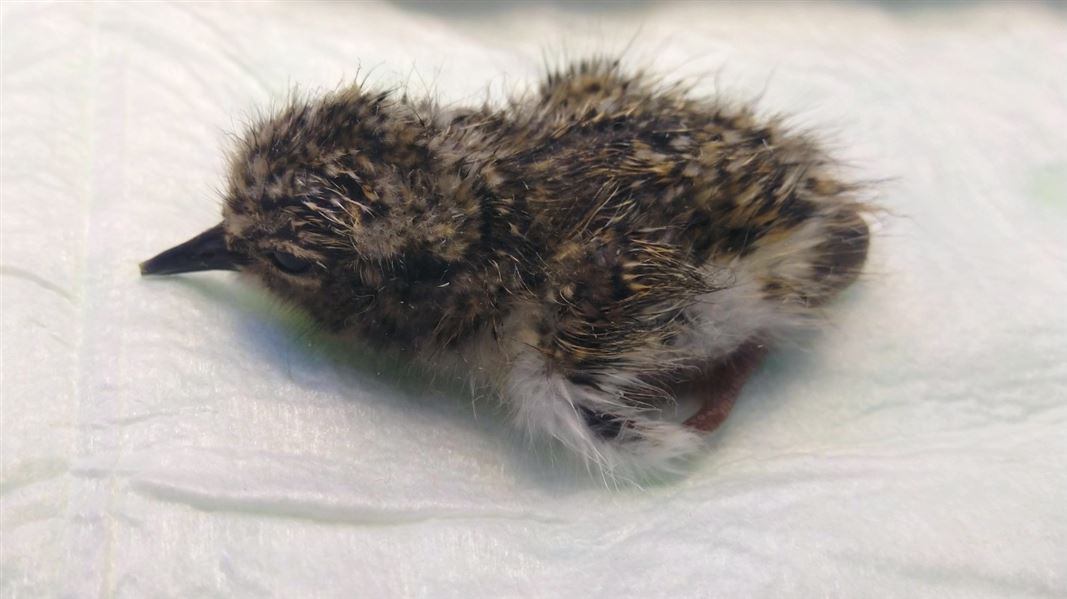
Introduction
Rare chicks from a remote island are hatching in Christchurch after a successful multi-day mission to increase the mainland gene pool of tūturuatu/tchūriwat’/shore plover.Date: 10 December 2020
Twenty-one eggs from these critically threatened shorebirds were collected by DOC and The Isaac Conservation and Wildlife Trust (ICWT) from Rangatira/Hokorereoro, an offshore predator-free island in the Chathams.
After months of planning, three weeks’ work on Rangatira/Hokorereoro, and an 800km journey by sea, air and land, the precious eggs arrived at ICWT’s captive breeding facility in Christchurch on 28 November.
The eggs began to hatch on 3 December at ICWT, where they will be raised, eventually boosting genetic diversity in the captive breeding programme and other wild populations.
The egg transfer was supported by the Hokotehi Moriori Trust and the Ngāti Mutunga o Wharekauri Iwi Trust.
DOC Technical Advisor and Captive Coordinator for the Tūturuatu Recovery Programme, Rose Collen, says these young chicks are mission-critical for the recovery programme and it has been an appropriately complex operation to get them here.
“Finding nests can be a challenge, as tūturuatu are very secretive when it comes to their eggs.”
“One bird in the nesting couple keeps a lookout and as soon as someone approaches, they’re off their nests. We had to do a ‘stake out’, hiding behind rocks or bushes to watch them return to the nest so we could spot where they were,” Rose Collen says.
Eggs were then checked to identify those at a stage of development that would be suitable for transferring, she says – developed enough to be safe to transport, but not so far that they would hatch in transit.
On ‘D-day’, the eggs were collected and transported in a temporary incubator by boat to main Rēkohu/Wharekauri/Chatham Island, then taken by plane to Christchurch and driven to ICWT. Transport plans had to be adjusted for weather in an attempt to ensure the smoothest possible journey for the fragile cargo.
“Rangatira is home to hundreds of amazing species but is particularly special for shore plover. As well as being their main stronghold – there are about 150 birds here, more than half of the global population – it’s also the site where the original eggs were taken from to start the captive breeding programme in the early ‘90s,” she says.
ICWT Assistant Wildlife Manager Leigh Percasky took part in the egg selection and transfer and says it is exciting to see the chicks beginning to hatch.
“The population on the Chathams is more genetically diverse than the population on the mainland because the last egg translocation happened so long ago.
“These chicks will allow us to breed more robust birds, which we hope will be less susceptible to diseases and create more viable breeding options for the captive breeding programme – which is essential for the future of the species,” Leigh Percasky says.
The Rangatira/Hokorereoro birds will be matched with suitable partners to have chicks of their own. This next generation will then add to the diversity of the small island populations around mainland New Zealand – like Waikawa/Portland Island on the East Coast and Motutapu in Hauraki Gulf.
“Shore plover are unique, lovely little birds. Even though they’re small, they have big hearts and big characters. They deserve our efforts to protect them,” says DOC’s Rose Collen.
Shore plover are a critically threatened shorebird endemic to NZ. They are incredibly vulnerable to predation from introduced predators, including rats and cats, and have a global population of around 250.
Background information
The survival of the endangered tūturuatu/shore plover relies on island biosecurity, captive breeding, and translocations to predator-free islands. These shorebirds have a threat ranking of Threatened – Nationally Critical.
By the 1870s cats and rats caused the tūturuatu to vanish from mainland coasts.
For more than 100 years, Rangatira/Hokorereoro in the Chatham Islands had the only known population of around 150 birds. The current wild population is less than 250 birds, more than half of which are in the Chatham Islands.
Today, Auckland’s Motutapu Island is the easiest place to see shore plover.
They are also found on Rangatira/Hokorereoro and Mangere Islands in the Chatham Islands, and Waikawa/Portland Island in Hawke’s Bay – all of which have restricted access.
Contact
For media enquiries contact:
Email: media@doc.govt.nz